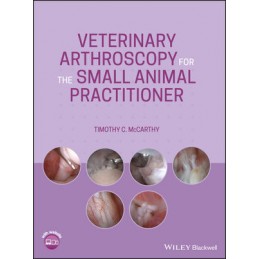- Reduced price

Order to parcel locker

easy pay


 Delivery policy
Delivery policy
Choose Paczkomat Inpost, Orlen Paczka, DHL, DPD or Poczta Polska. Click for more details
 Security policy
Security policy
Pay with a quick bank transfer, payment card or cash on delivery. Click for more details
 Return policy
Return policy
If you are a consumer, you can return the goods within 14 days. Click for more details
Veterinary Arthroscopy for the Small Animal Practitioner delivers a practical guide to all aspects of veterinary arthroscopy for small mammals. The book covers the anatomy, techniques, joint pathology, and operative procedures of arthroscopy.
The book includes a foundational introduction to basic tenets for veterinarians just beginning to use arthroscopy in their work as well as reference images for joint pathology useful to experienced practitioners. Nearly 1000 images are included in the reference, each of which illustrate one or more aspects of specific arthroscopic findings.
Veterinary Arthroscopy for the Small Animal Practitioner draws on the authors 35 years of clinical arthroscopic experience and offers a thorough examination of small animal arthroscopy. The book serves as a powerful demonstration of the centrality, practicality, utility, and necessity of arthroscopic veterinary procedures. Readers will also benefit from topics like::
Ideal for veterinary orthopedic surgeons and general veterinary practitioners, Veterinary Arthroscopy for the Small Animal Practitioner also belongs on the bookshelves of veterinary surgery residents and veterinary students seeking to improve their understanding of small animal arthroscopic surgery, pathology, anatomy, and techniques.
Data sheet
Preface xi
Acknowledgments xiii
About the Companion Website xiv
1 Introduction and Instrumentation 1
1.1 Introduction 1
1.2 Instrumentation and Equipment 3
1.2.1 Arthroscopes 3
1.2.2 Sheaths and Cannulas 5
1.2.2.1 Telescope Sheaths 5
1.2.2.2 Operative Cannulas 6
1.2.2.3 Egress Cannulas 8
1.2.3 Operative Hand Instruments 8
1.2.4 Power Instruments 12
1.2.4.1 Power Shavers 12
1.2.4.2 Radiofrequency/Electrocautery Instrumentation 14
1.2.5 Irrigation Fluid and Management Systems 15
1.2.5.1 Irrigation Fluids 15
1.2.5.2 Gravity Flow 16
1.2.5.3 Pressure Assisted Flow 16
1.2.5.4 Mechanical Arthroscopy Fluid Pumps 16
1.2.6 Video System Tower 17
1.2.6.1 Video Camera 18
1.2.6.2 Video Monitor 19
1.2.6.3 Light Source 19
1.2.6.4 Documentation Equipment 20
References 20
2 General Technique 23
2.1 Anesthesia, Patient Support, and Pain Management 23
2.2 Postoperative Care 23
2.3 Patient Preparation, Positioning, and Operating Room Setup 24
2.3.1 Shoulder Joint 24
2.3.2 Elbow Joint 26
2.3.3 Radiocarpal Joint 28
2.3.4 Hip Joint 29
2.3.5 Stifle Joint 29
2.3.6 Tibiotarsal Joint 31
2.4 Portal Placement-General 31
References 34
3 Shoulder Joint 36
3.1 Patient Preparation, Positioning, and Operating Room Setup 36
3.2 Portal Sites and Portal Placement 37
3.2.1 Telescope Portals 37
3.2.2 Operative Portals 39
3.2.3 Egress Portals 40
3.3 Nerves of Concern with Shoulder Joint Arthroscopy 40
3.4 Examination Protocol and Normal Arthroscopic Anatomy 41
3.5 Diseases of the Shoulder Diagnosed and Managed with Arthroscopy 47
3.5.1 Osteochondritis Dissecans (OCD) 47
3.5.1.1 OCD Lesion Removal and Management 59
3.5.2 Bicipital Tendon Injuries 73
3.5.3 Soft Tissue Injuries of the Shoulder with or Without Shoulder Instability 81
3.5.4 Ununited Caudal Glenoid Ossification Center (UCGOC) 95
3.5.5 Ununited Supraglenoid Tubercle (USGT) 100
3.5.6 Arthroscopic-Assisted Intra-Articular Fracture Repair 100
3.5.7 Arthroscopic Biopsy of Intra-Articular Neoplasia 101
3.5.8 Glenoid Cartilage Defects 102
3.5.9 Chondromalacia 104
3.5.10 Infraspinatus Muscle Contracture 104
References 106
4 Arthroscopy of the Elbow Joint 108
4.1 Patient Preparation, Positioning, and Operating Room Setup 108
4.2 Portal Sites and Portal Placement 109
4.2.1 Telescope Portals (Medial, Craniolateral, Caudomedial, and Caudal) 109
4.2.2 Operative Portals (Craniomedial, Lateral, Craniolateral, and Caudal) 111
4.2.3 Egress Portals 113
4.3 Nerves of Concern with Elbow Joint Arthroscopy 113
4.4 Examination Protocol and Normal Arthroscopic Anatomy 114
4.5 Diseases of the Elbow Diagnosed and Managed with Arthroscopy 122
4.5.1 Elbow Dysplasia 122
4.5.2 Osteochondritis Dissecans (OCD) 167
4.5.3 Ununited Anconeal Process (UAP) 176
4.5.4 Degenerative Joint Disease (DJD) 180
4.5.5 Assisted Intra-Articular Fracture Repair 180
4.5.6 Biopsy of Intra-Articular Neoplasia 181
4.5.7 Immune-Mediated Erosive Arthritis 182
4.5.8 Incomplete Ossification of the Humeral Condyle (IOHC) 182
4.5.9 Medial Enthesiopathy 183
References 184
5 Radiocarpal Joint 187
5.1 Patient Preparation, Positioning, and Operating Room Setup 187
5.2 Portal Sites and Portal Placement 187
5.3 Nerves of Concern with Radiocarpal Joint Arthroscopy 187
5.4 Examination Protocol and Normal Arthroscopic Anatomy 188
5.5 Diseases of the Radiocarpal Joint Diagnosed and Managed with Arthroscopy 189
5.5.1 Fractures 189
5.5.2 Soft Tissue Injuries 190
5.5.3 Immune-Mediated Erosive Arthritis 190
References 191
6 Hip Joint 192
6.1 Patient Preparation, Positioning, and Operating Room Setup 192
6.2 Portal Sites and Portal Placement 192
6.3 Nerves of Concern with Hip Joint Arthroscopy 193
6.4 Examination Protocol and Normal Arthroscopic Anatomy 193
6.5 Diseases of the Hip Diagnosed and Managed with Arthroscopy 196
6.5.1 Hip Dysplasia 196
6.5.2 Arthroliths 202
6.5.3 Soft Tissue Injuries of the Hip Joint 203
6.5.4 Assisted Intra-Articular Fracture Repair 205
6.5.5 Biopsy of Intra-Articular Neoplasia 206
6.5.6 Aseptic Necrosis of the Femoral Head 206
References 206
7 Stifle Joint 207
7.1 Patient Preparation, Positioning, and Operating Room Setup 210
7.2 Portal Sites and Portal Placement 210
7.2.1 Telescope Portal 210
7.2.2 Operative Portals 211
7.2.3 Egress Portal 211
7.3 Nerves of Concern with Stifle Joint Arthroscopy 213
7.4 Examination Protocol and Normal Arthroscopic Anatomy 213
7.5 Diseases of the Stifle Joint Diagnosed and Managed with Arthroscopy 221
7.5.1 Cranial Cruciate Ligament Injuries 221
7.5.2 Caudal Cruciate Ligament Injuries 258
7.5.3 Isolated Meniscal Injuries 258
7.5.4 Osteochondritis Dissecans(OCD) 259
7.5.5 Stifle Stabilization Failures 264
7.5.6 TPLO Second Look 264
7.5.7 Patellar Fracture Management 266
7.5.8 Long Digital Extensor Tendon Injuries 268
7.5.9 Popliteal Tendon Avulsion 268
7.5.10 Intra-articular Neoplasia 269
7.5.11 Patellar Luxation 270
7.5.12 Degenerative Joint Disease, Chondromalacia, and Synovitis 270
7.5.13 Discoid Meniscus 273
7.5.14 Osteochondromatosis 274
References 274
8 Tibiotarsal Joint 276
8.1 Patient Preparation, Positioning, and Operating Room Setup 276
8.2 Portal Sites and Portal Placement 276
8.2.1 Telescope Portals 276
8.2.2 Operative Portals 277
8.2.3 Egress Portal 278
8.3 Nerves of Concern with Tibiotarsal Joint Arthroscopy 278
8.4 Examination Protocol and Normal Arthroscopic Anatomy 278
8.5 Diseases of the Tibiotarsal Joint Diagnosed and Managed with Arthroscopy 279
8.5.1 Osteochondritis Dissecans (OCD) 279
8.5.2 Intra-Articular Fracture Management 286
8.5.3 Soft Tissue Injuries 287
8.5.4 Immune-Mediated Erosive Arthritis 287
8.5.5 Osteoarthritis 289
References 291
9 Problems and Complications 292
9.1 Actual and Potential Complications of Arthroscopy 292
9.1.1 Failure to Enter the Joint 292
9.1.2 Articular Cartilage Damage 292
9.1.3 Soft Tissue Damage 296
9.1.4 Bone Fragment Displacement 298
9.1.5 Operative Debris 298
9.1.6 Red Out 299
9.1.7 Peri-articular Fluid Accumulation 300
9.1.8 Infection 300
9.1.9 Vascular Injury 301
9.1.10 Nerve Injury 301
9.2 Instrument Damage 301
9.2.1 Intra-articular Instrument Breakage 301
9.2.2 Telescope Breakage 302
9.3 Contraindications 303
9.3.1 Patient Size 303
9.3.2 Septic Arthritis 303
9.3.3 Anesthesia Risk 303
References 304
Index 305
Reference: 70598
Author: Stephanie M. Porter
Reference: 9673
Author: Michael D. Lorenz
Postępowanie diagnostyczne u małych zwierząt
Reference: 58921
Author: Karen M. Tobias
2-Volume Set
Reference: 15062
Author: red. wyd. pol. Antoni Schollenberger
Przewodnik PSLWMZ
Reference: 101409
Author: Timothy C. McCarthy
